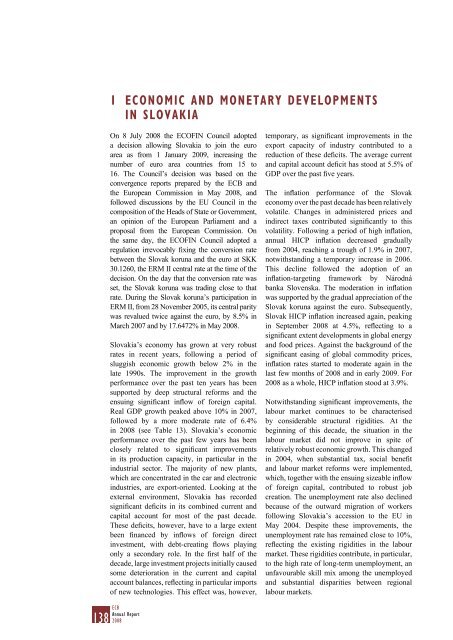ANNUAL REPORT 2008 - Polymer Bank Notes of the World
ANNUAL REPORT 2008 - Polymer Bank Notes of the World
ANNUAL REPORT 2008 - Polymer Bank Notes of the World
You also want an ePaper? Increase the reach of your titles
YUMPU automatically turns print PDFs into web optimized ePapers that Google loves.
1 ECONOMIC AND MONETARY DEVELOPMENTSIN SLOVAKIAOn 8 July <strong>2008</strong> <strong>the</strong> ECOFIN Council adopteda decision allowing Slovakia to join <strong>the</strong> euroarea as from 1 January 2009, increasing <strong>the</strong>number <strong>of</strong> euro area countries from 15 to16. The Council’s decision was based on <strong>the</strong>convergence reports prepared by <strong>the</strong> ECB and<strong>the</strong> European Commission in May <strong>2008</strong>, andfollowed discussions by <strong>the</strong> EU Council in <strong>the</strong>composition <strong>of</strong> <strong>the</strong> Heads <strong>of</strong> State or Government,an opinion <strong>of</strong> <strong>the</strong> European Parliament and aproposal from <strong>the</strong> European Commission. On<strong>the</strong> same day, <strong>the</strong> ECOFIN Council adopted aregulation irrevocably fixing <strong>the</strong> conversion ratebetween <strong>the</strong> Slovak koruna and <strong>the</strong> euro at SKK30.1260, <strong>the</strong> ERM II central rate at <strong>the</strong> time <strong>of</strong> <strong>the</strong>decision. On <strong>the</strong> day that <strong>the</strong> conversion rate wasset, <strong>the</strong> Slovak koruna was trading close to thatrate. During <strong>the</strong> Slovak koruna’s participation inERM II, from 28 November 2005, its central paritywas revalued twice against <strong>the</strong> euro, by 8.5% inMarch 2007 and by 17.6472% in May <strong>2008</strong>.Slovakia’s economy has grown at very robustrates in recent years, following a period <strong>of</strong>sluggish economic growth below 2% in <strong>the</strong>late 1990s. The improvement in <strong>the</strong> growthperformance over <strong>the</strong> past ten years has beensupported by deep structural reforms and <strong>the</strong>ensuing significant inflow <strong>of</strong> foreign capital.Real GDP growth peaked above 10% in 2007,followed by a more moderate rate <strong>of</strong> 6.4%in <strong>2008</strong> (see Table 13). Slovakia’s economicperformance over <strong>the</strong> past few years has beenclosely related to significant improvementsin its production capacity, in particular in <strong>the</strong>industrial sector. The majority <strong>of</strong> new plants,which are concentrated in <strong>the</strong> car and electronicindustries, are export-oriented. Looking at <strong>the</strong>external environment, Slovakia has recordedsignificant deficits in its combined current andcapital account for most <strong>of</strong> <strong>the</strong> past decade.These deficits, however, have to a large extentbeen financed by inflows <strong>of</strong> foreign directinvestment, with debt-creating flows playingonly a secondary role. In <strong>the</strong> first half <strong>of</strong> <strong>the</strong>decade, large investment projects initially causedsome deterioration in <strong>the</strong> current and capitalaccount balances, reflecting in particular imports<strong>of</strong> new technologies. This effect was, however,temporary, as significant improvements in <strong>the</strong>export capacity <strong>of</strong> industry contributed to areduction <strong>of</strong> <strong>the</strong>se deficits. The average currentand capital account deficit has stood at 5.5% <strong>of</strong>GDP over <strong>the</strong> past five years.The inflation performance <strong>of</strong> <strong>the</strong> Slovakeconomy over <strong>the</strong> past decade has been relativelyvolatile. Changes in administered prices andindirect taxes contributed significantly to thisvolatility. Following a period <strong>of</strong> high inflation,annual HICP inflation decreased graduallyfrom 2004, reaching a trough <strong>of</strong> 1.9% in 2007,notwithstanding a temporary increase in 2006.This decline followed <strong>the</strong> adoption <strong>of</strong> aninflation-targeting framework by Národnábanka Slovenska. The moderation in inflationwas supported by <strong>the</strong> gradual appreciation <strong>of</strong> <strong>the</strong>Slovak koruna against <strong>the</strong> euro. Subsequently,Slovak HICP inflation increased again, peakingin September <strong>2008</strong> at 4.5%, reflecting to asignificant extent developments in global energyand food prices. Against <strong>the</strong> background <strong>of</strong> <strong>the</strong>significant easing <strong>of</strong> global commodity prices,inflation rates started to moderate again in <strong>the</strong>last few months <strong>of</strong> <strong>2008</strong> and in early 2009. For<strong>2008</strong> as a whole, HICP inflation stood at 3.9%.Notwithstanding significant improvements, <strong>the</strong>labour market continues to be characterisedby considerable structural rigidities. At <strong>the</strong>beginning <strong>of</strong> this decade, <strong>the</strong> situation in <strong>the</strong>labour market did not improve in spite <strong>of</strong>relatively robust economic growth. This changedin 2004, when substantial tax, social benefitand labour market reforms were implemented,which, toge<strong>the</strong>r with <strong>the</strong> ensuing sizeable inflow<strong>of</strong> foreign capital, contributed to robust jobcreation. The unemployment rate also declinedbecause <strong>of</strong> <strong>the</strong> outward migration <strong>of</strong> workersfollowing Slovakia’s accession to <strong>the</strong> EU inMay 2004. Despite <strong>the</strong>se improvements, <strong>the</strong>unemployment rate has remained close to 10%,reflecting <strong>the</strong> existing rigidities in <strong>the</strong> labourmarket. These rigidities contribute, in particular,to <strong>the</strong> high rate <strong>of</strong> long-term unemployment, anunfavourable skill mix among <strong>the</strong> unemployedand substantial disparities between regionallabour markets.138 ECBAnnual Report<strong>2008</strong>




![KNOW YOUR NEW GIBRALTAR BANKNOTES - [Home] bThe/b](https://img.yumpu.com/50890985/1/184x260/know-your-new-gibraltar-banknotes-home-bthe-b.jpg?quality=85)
![PAPUA NEW GUINEA - [Home] - Polymer Bank Notes of the World](https://img.yumpu.com/49758743/1/190x143/papua-new-guinea-home-polymer-bank-notes-of-the-world.jpg?quality=85)










